December 1, 2016 Ryukyu Shimpo
The police’s investigation is a form of oppression against the anti-base protests. Conducting a compulsory investigation of the Okinawa Peace Movement Center and arresting its Chairman Hiroji Yamashiro for the third time and detaining him for a long period is going too far. One cannot help but feel that this goes against the philosophy of “fairness and impartiality” that the Police Law insists on.
The Okinawa prefectural police confiscated computers etc. from the Peace Movement Center, which is the hub for military base protests and peace movements. Information regarding those involved in the movements was handed over to the public authorities, effectively shrinking the anti-base protests. The need to investigate and confiscate is questionable. The need to detain Chairman Yamashiro for a long period is similarly questionable. All of this is making Okinawans wonder if the police are supporting the national policy to construct a base. This has greatly wavered Okinawans’ trust in the Okinawan police.
Doubt in the need to investigate
There are many doubts regarding the police’s investigation. For example, why are the compulsory investigation of the case in January and the arrest of chairman and others only happening now, close to a year after the fact?
Many suspect impression management is at play to suppress protests against the new Henoko base construction. The ruling party of the Okinawa Prefectural Assembly, namely the Liberal Democratic Party, approves of the construction. A spokesman from the party says, “The main battlefield will move from Takae to Henoko. If the construction (in Henoko) resumes, then the protests will rekindle as well. Policing is and will be needed.” It seems that they waited for the right moment to conduct the investigation.
Supposedly, the aim of the investigation was rooted in the suspicion of destruction of business by force via stacking blocks on the road in front of the gate to the U.S. military base. It was done openly in front of the police, evidently making it easy to determine what had happened and who was responsible for it. But is there really a need to arrest the chairman etc. and confiscate documents from the Peace Movement Center to build a case for that?
A spokesman of the Okinawan police claims that “It took some time to determine the suspects and for a corroborative investigation.” But this still does not rid of the suspicion toward confiscating massive amounts of documents.
Perhaps their real aim was not only to build a case against stacking those blocks, but also to collect information on a wide range of topics, such as the protests against the new Henoko base, construction of the helipads in the Northern Training Area, and on those involved. Doubt increases as people question the preparatory police activities that seem to also include managing future protests in its scope.
Detaining Chairman Yamashiro for more than 40 days is also a problem. Once again, there is doubt in the need for an investigation that involves detaining a person for a long period over petty suspicions, such as destruction of property etc. It also is a human rights issue. At the same time, it greatly affects the anti-base protests.
Many legal experts, such as lawyers and college professors, have pointed out the lack of need for a compulsory investigation. They say that it suppresses freedom of expression and political activity. People suspect that the real aim of the compulsory investigation was to shrink the protests. The police are supposed to stand between the government that tries to push through with the construction of the base and Okinawans who oppose it. They are supposed to conduct police activities with “fairness and impartiality” However, the police are no longer able to strike a balance between the two parties; this is how they are being seen.
Meanwhile, two newspaper journalists covering the Takae helipad construction were detained and removed from the scene by riot police. The policemen involved in this incident have neither been punished, nor have they apologized. Even in this regard, the police have lost their balance.
Opposing the bases is a legitimate right
There is fear over the government and the police becoming one entity. In last year’s Police Law amendments, “Helping with the Cabinet’s important policies” was added to the police’s duty. It makes one wonder if the construction of the new Henoko base is being categorized as one of “the cabinet’s important policies.” At the very least, a series of police activities that include the thorough removal of helipad protestors makes one feel that preceding doubt.
Lawyers are criticizing the polices’ response, calling it worse than when Okinawa was under U.S. military control. Some experts are even concerned about the dangerous signs of a “police state” in which the police support the government’s national policies.
The government justifies the construction of the new Henoko base and policies to focus bases in Okinawa with security reasons, such as “removing hazards from Futenma” and “Okinawa’s geological advantage.” But the reality is that the government continues to push for Okinawa to bear the heavy burden of hosting the bases under the pretense of “national interest.” Okinawans are not the attackers, but the victims.
For Okinawans, who suffer damages, to push for reducing the heavy burden of hosting bases and to oppose a new base and facilities is a legitimate right. For the government and police as one entity to oppress asserting one’s legitimate right based on democracy and local autonomy and acts to protest against the base is unacceptable.
Removing the U.S. military bases is a long and hard battle for Okinawans. But justice is on Okinawa’s side. People have no choice but to persevere and continue to fight without bowing down to the unjust actions of the government and police.
(English translation by T&TC and Chelsea Ashimine)
Go to Japanese
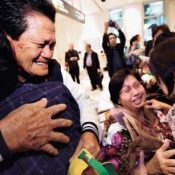
December 2, 2016 Ryukyu Shimpo
Three second-generation Japanese left behind in the Philippines in the war returned to Japan for the first time on December 1. The father of the three children is Taruji Fusato from Itoman City who died in 1990. His 78-year-old third daughter, Sarome Fumiko Fusato, 76-year-old third son, Haime Fusato, and 71-year-old fifth daughter Karidad Kazuko Fusato finally retrieved their Japanese citizenship in October after being categorized as stateless due to the destabilized situation during and after World War II. The three children were welcomed by relatives when they arrived at the Naha Airport. They said, holding back tears, they didn’t think they would ever be able to stand on their father’s land.
Taruji moved to the Philippines in 1918 to work as a fisherman. He later married a Filipino woman and had three sons and five daughters, however he was then held as a captive by the U.S. military during WWII and was deported to Japan.
Fumiko and her other siblings acquired Japanese nationality with the support of the Nippon Foundation and other parties. According to the foundation, 188 people have retrieved their census registration, of which 38 are Okinawans.
The three siblings met 67-year-old Mitsuko Kamita, one of their relatives, for the first time. Fumiko reflected, “It’s too bad we cannot see our father, but I’m grateful that our relatives welcomed us.” Haime also wiped away tears and said, “In the letter he sent 55 years ago, our father said he wanted to see us. I thought it would be impossible, but in the end we were able to come to Japan.” Kazuko continued, “We thank those who supported our efforts to get nationality.”
The siblings will stay until December 4 and will visit Taruji’s burial place.
(English translation by T&CT and Sayaka Sakuma)
Go to Japanese
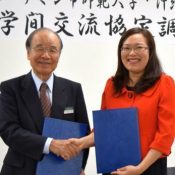
November 30, 2016 Ryukyu Shimpo
Okinawa University has made a deal with Ho Chi Minh City University of Teacher Training to promote an exchange program between Okinawa and Vietnam. A signing ceremony was held at the university on November 30. President of the Okinawa University Hiroshi Nakachi has signed the contract that vice president of Ho Chi Minh City University of Teacher Training Nguyen Thi Minh Hong brought, hoping for further development of both schools. Ho Chi Minh City University of Teacher Training is the seventh overseas school that Okinawa University has made a deal with.
As part of study tour programs, students of Okinawa University have made annual visits to Ho Chi Minh City University of Teacher Training since 2014, promoting exchange between students. The programs have prompted Okinawan students to get jobs or enroll in schools in Vietnam. For the sake of further development of student exchange, the schools made the agreement.
From now on, the universities will implement exchange of students, faculties, academic information, and carry out collaborative projects. Specifically, both schools will implement a one-year student exchange program and shorter exchanges for students on vacation. The schools will accommodate visiting students and support their lives and studies.
(English translation by T&CT)
Go to Japanese
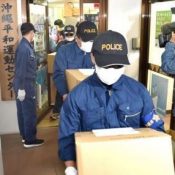
November 30, 2016 Ryukyu Shimpo
On November 29, the Okinawa Prefectural Police and the Nago Police Station arrested four people including Chairman Hiroji Yamashiro of the Okinawa Peace Movement Center. The arrests were made in relation to a protest in January against construction of Futenma Air Station replacement facility. Protesters piled concrete blocks in front of the gate to Camp Schwab in order to keep construction vehicles from entering the camp and obstruct Okinawa Defense Bureau (ODB) activity. The Prefectural Police have conducted several premises searches related to the arrests. Ryukyu Shimpo has confirmed six locations that were searches, but according to officials involved in the searches there are eight. On November 25, the Prefectural Government approved the construction on land inside Camp Schwab, and it appears that the police aim to restrain protect activities prior to the construction proceeding at full speed.
Chairman Yamashiro, a 66-year-old man from Ginoza Village, a 59-year-old man from Nago City, and a 40-year-old man from Nago City are the four who were arrested. The police have not revealed whether any of the suspects have been arraigned, on the grounds that releasing that information would hinder their investigations.
The charges for which the arrests were made took place between about 2:05 p.m. on January 28 and 8:41 a.m. on January 30. They are under suspicion of piling up 1,400 concrete blocks about 5 meters across and 2 meters high on the road leading to Camp Schwab’s gate, blocking the entrance in order to obstruct replacement facility construction. The suspicion is also that several protesters stood together in the way of construction vehicles, barring their entrance and interfering with ODB activity.
Prefectural Police conducted premises searches in the morning on November 30 at Chairman Yamashiro’s residence, the tents in front of Camp Schwab’s gate where citizens opposed to Henoko base construction, the Okinawa Peace Movement Center, and several related locations within Okinawa. They seized dozens of documents and other articles.
Concerning the four arrested people, the Prefectural Police said that the four men played leading roles in the protests, and Chairman Yamashiro, in particular, incited the protest activities. As for the timing of the arrests, the Prefectural Police explained that many people were involved in the incident, and they spent some time identifying the perpetrators and investigating grounds for the arrests.
Lawyer Shunji Miyake interviewed the arrested citizens at Nago Police Station, and explained that they are all keeping silent. He also explained that the protest took place under police surveillance: The act of piling blocks, which is being used as a basis for proving forcible obstruction of official business, was done before the police’s eyes and was repeated after the police removed the blocks the next day. He pointed out that the police’s actions and their reasons for the arrest are inconsistent, and said that if it was forcible obstruction of official business the police would have to have stopped the citizens before they piled the blocks. In addition, he criticized that, “Almost a year had passed [since they engaged in the protest activity] by the time they were arrested,” and professed he had no words to describe the strangeness of this situation.
(English translation T&CT and Erin Jones)
Go to Japanese
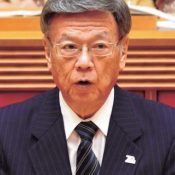
November 30, 2016 Ryukyu Shimpo
On the evening of November 29, Governor Takeshi Onaga told reporters that despite his statement at a news conference the day before that the partial return of the U.S. military’s Northern Training Area conditioned on the construction of new helipads presented “the ultimate painful decision”, he does not accept the helipad construction. “I do not accept that the helipad construction is moving forward despite the fact that no environmental impact assessment has been done with regard to the Osprey deployment,” explained Onaga.
Onaga mentioned that in 1996, when the Special Action Committee on Okinawa (SACO) final report was published and the partial return of the Northern Training Area and relocation of helipads was agreed upon, the plan to use the new helipads for the use of the Marines’ MV-22 Osprey transport aircraft had not yet been revealed, and said that the construction of helipads for Osprey use “differs from what was in the SACO agreement.”
Governor Onaga said that reports that interpreted his “painful decision” comment as indicating acceptance of the helipad construction did not capture his intended meaning.
Meanwhile, he explained, “It can’t be helped if you [news media] interpreted my comment in that way. That was the interpretation of the media, but it would not have been right for me to explain.”
At the press conference on November 28, when asked for a comment on the fact that the partial return of the Northern Training Area is not happening in a way that satisfies with the wishes of the local communities, Governor Onaga said, “It is difficult to object to the return of roughly four thousand hectares of land.”
He further stated, “If the Osprey are entirely removed [from Okinawa], it would probably be difficult to utilize the helipads fully. When thinking about the steady implementation of the SACO report and the relationship of trust with the two villages [of Higashi and Kunigami], I think everything converges on the removal of the Osprey,” emphasizing his belief that removal of the Osprey would render the helipads useless.
• Ceremony for partial return of Northern Training Area to be held on December 22
The national government has begun the final stages of planning for a return ceremony on December 22 to celebrate the partial return of the Northern Training Area. The partial return is conditioned on the construction of new helipads currently being carried out by the central government, and the government plans to finish the construction in mid-December. Plans are being made for the ceremony to be attended by Chief Cabinet Secretary Yoshihide Suga and other relevant cabinet member from the Japanese side and Ambassador Caroline Kennedy and others from the U.S. side. The government also plans to invite Governor Takeshi Onaga to the ceremony.
* Two articles have been combined into one for this digital edition article.
(English translation by T&CT and Sandi Aritza)
Go to Japanese
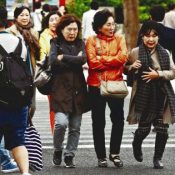
November 25, 2016 Ryukyu Shimpo
The temperature dropped in Okinawa as cold air covered the area on November 24, the same day the first snow for the season was observed in Tokyo. The air temperature dropped to lower than the previous day in all 28 temperature observation stations in the prefecture. At twenty out of the 28 locations the lowest temperature this season was observed. The temperature dropped to 15.7 degrees celcius in Oku, Kunigami Village, and 16.2 degrees in Tokashiki, Tokashiki Village.
On the same day, Naha recorded its lowest temperature, at 18.4 degrees. Many people in the city could be seen walking in thick jackets.
According to the Okinawa Meteorological Observatory, both the highest and lowest temperature will be lower than in previous years on November 25, and the weather is expected to be cloudy due to the frontogenesis and humid air.
(English translation by T&CT and Sayaka Sakuma)
Go to Japanese
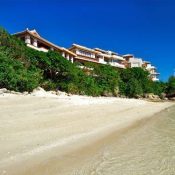
November 23, 2016 Ryukyu Shimpo
Hotel “Hyakuna Garan” in Nanjo City has taken out three international awards. The “World Boutique Hotel Award” is dedicated to hotels which offer high-quality service regardless of hotel size. In the food and drink section, Hyakuna Garan was the only one to be awarded in Asia.
Besides this award, Hyakuna Garan received the “World Luxury Hotel Award” in recognition of the world-class facilities and service excellence provided to guests. It also won the “Luxury Travel Guide Award” which is awarded by continent.
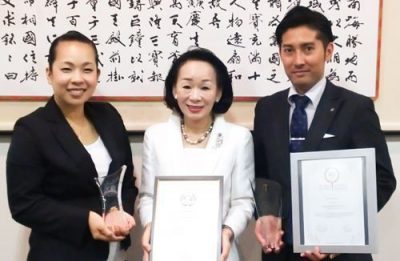
On November 22, 2016, at Ryukyu Shimpo, Owner Miki Fuchibe (middle), Sub manager Kayoko Ikeda (left), and Yasuto Morishima Sales Manager hold the World Boutique Hotel Award and a plaque.
The world’s largest travel site “TripAdvisor” awarded the hotel a Certificate of Excellence to recognize year-long glowing reviews and another award for the best small hotel out of hundreds of other hotels.
On November 22, owner Miki Fuchibe, Sub-manager Kayoko Ikeda, and Yasuto Morishima Tourism Marketing Division Assistant Sales Manager of JCC, which manages the hotel, visited the Ryukyu Shimpo office and shared the good news.
For the World Boutique Hotel Award, the creation of Ryukyuan and Japanese dishes, and the unique fusion of history and tradition were recognized. Owner Fuchibe said, “We would like to present the charm of not only Nanjo City but also Okinawa to the world and aim to become ‘the Chosen Okinawa.’”
(English translation by T&CT and Megumi Chibana)
Go to Japanese
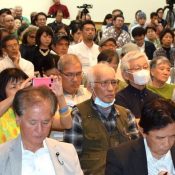
November 27, 2016 Ryukyu Shimpo
On the evening of November 26, at a youth assembly hall (Okinawa-ken Seinenkaikan Horu) in Naha City, an Okinawan group opposing military base relocation within Okinawa held an urgent symposium on protecting the whole of Yambaru from becoming a danger zone in the Ie-jime, Takae, and Henoko triangle. Two hundred and fifty people attended the symposium. During the panel discussion problems such as helipad construction, Henoko base construction, and Ie-jima landing strip extension were examined from various angles, including construction illegality and environmental destruction.
In regards to helipad construction in Takae, biologist Masako Yafuso explained that there is no established method to restore the subtropical nature that has been destroyed. She said that the important thing now is to halt construction, even if only for a minute.
Tsuyoshi Kitaueda, a member of the Peace Citizens’ Liaison Committee, showed understanding for the Prefectural Government’s acceptance of resumed construction on Camp Schwab barracks. However, he said that for base construction in Henoko 56,000 tetrapods (wave-dissipating concrete blocks) would be necessary, and a concrete plant will be built in order to produce these. He emphasized, “[The concrete plant is] separate of barracks construction, and we will absolutely not allow it to be built.”
Yoshikazu Makishi, an architect, showed concern about resumed construction on the barracks. Mentioning a plan for ten-odd barrack buildings to be constructed in the vicinity of Henoko Dam, he went on to point out the overall importance of forcing the Japanese government to stop the construction itself.
Journalist Tomohiro Yara said that Japan should cooperate with American think tanks based in Washington, D.C., start negotiations with the U.S. by suggesting that the U.S. military could make progress in the Asia-Pacific region without putting Marines in Okinawa.
Minoru Naka of the Ie Village Council was present at the symposium, and hurriedly went onstage to give a report on the effects and other matters related to landing strip extension at Ie-jima Auxiliary Airfield.
(English translation by T&CT and Erin Jones)
Go to Japanese
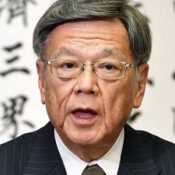
November 29, 2016 Ryukyu Shimpo
On November 28, Okinawa Governor Takeshi Onaga held an interview with multiple news outlets in advance of the two-year anniversary of his inauguration as governor on December 10. Regarding the plan to return slightly more than half of the U.S. military’s Northern Training Area in Higashi Village and Kunigami Village, the return being conditioned on construction of new U.S. military helipads, Onaga said, “This is the ultimate painful decision. It is difficult to object to the return of roughly four thousand hectares of land,” essentially expressing acceptance of the helipad construction.
Onaga then said, “When thinking about the steady implementation of the SACO (Special Action Committee on Okinawa) report and the relationship of trust with the two villages [of Higashi and Kunigami], I think everything converges on the removal of the Osprey.” When announcing his campaign pledges in October 2014 prior to being elected, Onaga explicitly stated that he opposed the helipads in connection with his call for the Osprey to be removed from Okinawa, and his recent comment thus constitutes a practical revocation of his campaign pledge. He reaffirmed his stance of continuing to oppose the new base construction in Henoko.
Regarding the current situation in the Northern Training Area, Onaga criticized the Japanese government’s methods, saying, “It is dreadful that Osprey are flying the skies with no environmental impact assessment having been performed [regarding their use]. In proceeding with the construction, [the government] began construction just hours after the results of the House of Councilors election were announced, which did nothing to win the trust of Okinawans.” He further stated that “Okinawans are calmly observing [the government’s assertion that] we should not complain because four thousand hectares will be returned” and that “if the Osprey are removed, it would probably be difficult to utilize the helipads fully.”
When asked how he would deal with the situation if the Supreme Court rejects Okinawa’s appeal in the lawsuit over the Henoko land reclamation, Onaga referred to the authority he has as governor regarding reapplication for and design changes to the reef fracturing permit for the ocean near Henoko and coral transplanting. “Even if the land reclamation permit is reinstated, I am still able to make individual decisions regarding each specific issue. In doing so, I want to stick to my view [of opposition to the new base construction],” said Onaga, reaffirming his intention to continue expressing opposition to the new base construction.
When asked his opinion of the possibility of building a new facility in Henoko within the existing base there without reclaiming any land from the ocean, Onaga referred to his campaign pledge to have Futenma relocated outside of Okinawa and merely said, “I want to achieve success in expressing to the central government the wish that it stop insisting that ‘Henoko is the only option’ and prevent a new base from being built in Henoko.”
Onaga expressed determination in improving the understanding of Japanese people outside of Okinawa regarding the base burden borne by Okinawa, saying, “this has progressed in various ways, but I think there is still indifference, so I want to continue conveying [the situation] to many people in various ways.”
Looking back on his two years as governor, Onaga said, “I believe I have put in my full efforts. We have begun initiatives to move forward with almost all of the more than 200 pledges I made during my campaign.” He expressed his intention to strengthen initiates even further toward achieving an Asian economic strategic vision and tackling the issue of childhood poverty.
Regarding the current state of the “All Okinawa” movement that was formed during the gubernatorial election, Onaga said, “I believe politics has come together with the sentiment of the people.”
(English translation by T&CT and Sandi Aritza)
Go to Japanese
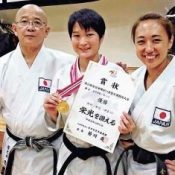
November 25, 2016 Wakana Hanmine of Ryukyu Shimpo
An unexpected bond between three generations of masters and an apprentice has resulted in a karate champion. Aika Arakaki is a 23-year-old who is deaf and practices karate while working at a confectionery factory in Naha. In October, she won for the first the Women’s Individual Kata in the Persons with Physical Disabilities Division (Deaf/Hard of Hearing) of the 12th All Japan Karatedo Championships for Persons with Disabilities. Behind her success are her two masters.
“I won first place,” Arakaki said as she raised her medal into the sky after the championship. She had raised it toward Shizue Yogi, her master who passed away at age 40 this past March. Arakaki also informed her other master by showing him the medal and certificate of recognition in early November. It was Tsuguo Sakumoto, a 68-year-old former world champion and vice chairman of the Okinawa Amateur Sports Association, who became her new master following Yogi’s passing. Sakumoto says, “It felt like Shizue had sent a message from heaven saying, ‘Take care of Aika.’”
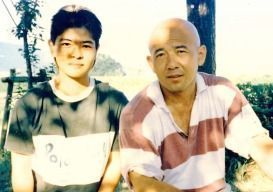
Shizue Yogi next to Tsuguo Sakumoto during a training camp for Urasue High School’s Karate Club (Provided by Kiyomi Yogi)
Arakaki had been training under Yogi since her high school years, but Yogi passed away this past March from cancer. Meanwhile, Sakumoto read about a woman training alone following her master’s passing in a Ryukyu Shimpo article in July and volunteered to train her.
“(Your master was) Shizue?” said Sakumoto. He was surprised to hear the name of Arakaki’s late master when he and Arakaki first met. In turns out, Yogi was Sakumoto’s apprentice whom he favored and trained directly when they were a part of Urasue High School’s Karate Club from 20-something years ago.
Yogi had not told Arakaki she had cancer and continued to train Arakaki until several months before her passing. Arakaki was despondent for a while and was not able to bring herself to practice karate following her master’s sudden death. It was then that Sakumoto offered her a lending hand. “It really was because of Yogi Sensei and Sakumoto Sensei that I was able to became Japan’s best,” Arakaki said as she broke into a smile.
This was Arakaki’s third time entering the championship. Last year, she finished last because of a lack of practice. “As long as I keep doing what they’ve taught me, I can do this,” she kept telling herself as she performed the kata Seipai, which was handed down by Yogi and Sakumoto. The efforts of her practice bore fruit during the championship.
It was Sakumoto who refined Arakaki’s Seipai, which was taught by Yogi. It so happens that Seipai was Yogi’s specialty kata, which was taught by Sakumoto.
Sakumoto, along with 34-year-old Yuka Shimizu, trained Arakaki at the dojo. Since Arakaki is deaf, Shimizu helped improve Arakaki’s technique by writing down Sakumoto’s advice and showing them to her. Shimizu says, “(Arakaki) can’t hear, but she soaks up techniques by sharpening all of her body’s senses.”
(English translation by T&TC and Chelsea Ashimine)
Go to Japanese












 Webcam(Kokusai Street)
Webcam(Kokusai Street)


